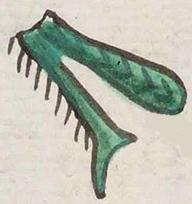Chapolicxitlan (Mdz8r)
This simplex glyph represents a grasshopper foot (chapolicxitli). It is really a full leg, colored green, bent, and it has hairs on the lower part and texturing on the upper part.
Stephanie Wood
The visual is a simplex glyph, but the term for grasshopper foot has two elements, chapolin (grasshopper) and icxitl) (foot). The hairs and the woven-like texturing on the grasshopper leg show how familiar the Nahua artist was with the insect. This open-access image of an American grasshopper from Wikipedia sustains these minute details that the artist gave to the grasshopper leg. Knowing as we do that grasshoppers are considered a food still in Mexico today (especially in Oaxaca), we can understand how the Nahuas had a close-up view of them and were able to discern the patterns on the leg.
Stephanie Wood
chapolycxitla.puo
Chapolicxitlan, pueblo
Stephanie Wood
c. 1541, or by 1553 at the latest
Stephanie Wood
nombres de lugares

chapolicxi(tl), grasshopper foot, https://nahuatl.wired-humanities.org/content/chapolicxitl
chapol(in), grasshopper, https://nahuatl.wired-humanities.org/content/chapolin
icxi(tl), foot, https://nahuatl.wired-humanities.org/content/icxitl
-tlan (locative suffix), https://nahuatl.wired-humanities.org/content/tlan
el pie del chapulin
Stephanie Wood
Codex Mendoza, folio 8 recto, https://digital.bodleian.ox.ac.uk/objects/2fea788e-2aa2-4f08-b6d9-648c00..., image 26, of 188.
The Bodleian Libraries, University of Oxford, hold the original manuscript, the MS. Arch. Selden. A. 1. This image is published here under the UK Creative Commons, “Attribution-NonCommercial-ShareAlike 3.0 License” (CC-BY-NC-SA 3.0).


